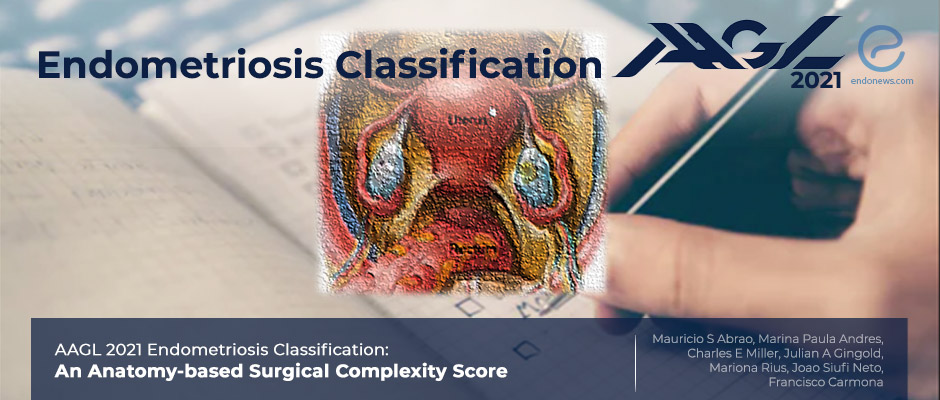The new Endometriosis Surgical Complexity Classification: AAGL 2021
Dec 10, 2021
This study measured the credibility of a new classification system AAGL 2021.
Key Points
Highlights:
- AAGL 2021 endometriosis scoring is an objective scoring that reflects intraoperative surgical complexity and competently correlates with pain and infertility symptoms.
- The score is derived from intraoperative findings and the calculation is easy at the time of laparoscopy.
Importance:
- A reliable method of surgical complexity would provide significant assistance to the patients aiming for surgery and also help to determine subspecialty assistance or referral to a tertiary center.
What's done here:
- Based on the American Association of Gynecologic Laparoscopists (AAGL) task force in 2010, this prospective multicenter study aimed to score intraoperative surgical complexity and its relation to patient-reported pain and infertility.
- Evaluating the survey completed by internationally recognized endometriosis specialists who estimated the complexity of surgical excision of endometriosis, a “difficulty score” for each anatomic site, and an overall "complexity score" was built.
- Validation was performed on 1224 endometriosis patients treated in 3 well-known centers from Brazil and Spain.
- Patients were staged according to both the rASRM and the new AAGL-2021 classification systems by the surgeons during their laparoscopic operations.
Key results:
- Comparison of the percentages of rASRM to AAGL-2021 systems were 23,2 vs 18.7, 24,4 vs 26.2, 17,6 vs 12.0, and 34,7vs 42.9 for the stages I, II, III, and IV respectively.
- The surgical complexity scale concordance for the AAGL stage was 69.2% and 46.6% for rASRM.
- Although there is some correlation, surgical complexity is better interpreted by the AAGL system, compared to ASRM.
- The comparison of the above two staging systems had similar correlations with overall pain scores, severe pain symptoms, and infertility.
Limitations:
- The score construction is based on the input of expert surgeons, the opinion of less specialized surgeons would have reflected surgical difficulty in general gynecologic practice (but the internal consistency would be poor).
- Being the first published validation study for the 2021 AAGL Endometriosis Classification System, future studies should confirm its use in other populations/countries/by different surgeons-general gynecologists, fertility specialists, and endometriosis specialists.
- The disease burden at extra-abdominal or upper abdominal sites is not represented.
Lay Summary
Multiple endometriosis categorizations have been approved in the recent forty years. The American Fertility Society proposed ASRM with a desire to score the impact of the endometriosis in 1996, which was updated several times later (rASRM), to predict infertility after laparoscopic operations. For anticipating the pregnancy rates, Endometriosis Fertility Index was developed in 2010; and to facilitate the classification of deep infiltrating endometriosis, the Enzian classification system emerged, which describes mapping, locating, sizing the endometriotic lesions with a cut-off value of peritoneal invasion>5 mm for deep infiltrating endometriosis definition.
Based on the requirement of an anatomy-based, user-friendly surgical complexity scoring system that preferably correlates with pain and infertility problems of the patients, the American Association of Gynecologic Laparoscopists (AAGL) decided to develop a new scoring system and assigned a task force in 2010. This prospective multicenter report is the first to record the data emerging from the data of this task force and named as AAGL-2021 scoring system. The detailed article has recently been published in the "Journal of Minimally Invasive Gynecology".
For the development of the score, the team sent a survey to internationally recognized endometriosis specialists and asked them to estimate the complexity of surgical excision of endometriosis, and an average “difficulty score” for each anatomic site was built. The difficulty scores of each anatomic site were computed, the sum across all anatomic sites created the complexity score. Abrao et al from the University of San Paul, Brazil validated the score established in this study evaluating the surgical data from three recognized endometriosis centers in Brazil and Spain.
The results revealed that the AAGL scoring system discriminated between 4 stages of surgical complexity with a high reproducibility while the ASRM scoring system failed to discriminate the surgical complexity. Furthermore, this new system is also correlated with the patients' pain and infertility symptoms, equally comparable with the ASRM scoring system.
Although noninvasive methods for endometriosis diagnosis are improving, the authors mentioned that they are actively studying the feasibility of preoperative prediction of the AAGL Endometriosis Classification score. "A reliable preoperative scoring system determining surgical complexity would provide specific assistance for contemplating surgery and referring cases to a tertial center for subspecialists", they added.
Research Source: https://pubmed.ncbi.nlm.nih.gov/34583009/
classification staging pelvic pain rASRM AAGL 2021 endometriosis infertility dysmenorrhea anatomic site

